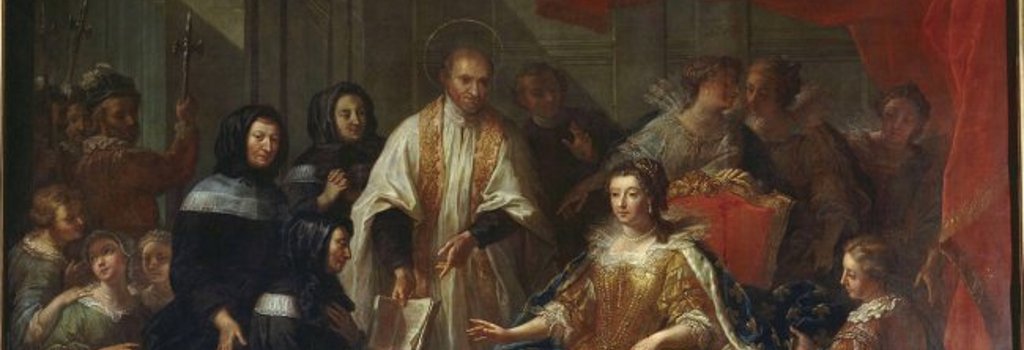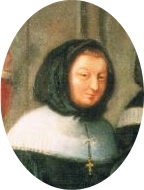
 Among the Ladies of Charity that Saint Vincent de Paul gathered around him was Madame de Pollalion, with whom he founded the Institute of Union-Chrétienne de Saint Chaumond in Paris in 1652.
Among the Ladies of Charity that Saint Vincent de Paul gathered around him was Madame de Pollalion, with whom he founded the Institute of Union-Chrétienne de Saint Chaumond in Paris in 1652.
In 1630, under the management of Monsieur Vincent and accompanied by generous women, Madame de Pollalion had the inspiration to open a house to care for young girls in difficulty. This house bore the name of the Institute of the Daughters of Providence and was set up in Charonne, a suburb of Paris.
In 1648, St Vincent de Paul had the instinct to gather seven of these generous souls around Madame de Pollalion to devote themselves more specifically to the formation and education of young girls. Four years later, on October 17, 1652, in the presence of Saint Vincent de Paul,
“they promised God through a pure love to unite themselves to Jesus Christ through a continual meditation and through a faithful meditation on his holy life, to proclaim his kingdom everywhere, even in foreign countries, and to remain united to Jesus Christ and to one another through the inseparable bond of fraternal love, assisting one another in everything possible.”
Union-Chrétienne was founded.
This name chosen by Saint Vincent de Paul himself expresses the union of the sisters with Jesus Christ and with one another. The patronage of Saint Chaumond was added because the private mansion in Paris in which they lived at the beginning bore the name. The foundation corresponded to a need. The sisters were well appreciated and were called to found several houses in Paris, then very quickly in the provinces. In turn, some of the houses founded others. The sisters of Union-Chrétienne de Saint Chaumond went under the direct jurisdiction of the Pope on May 15, 1668. This agreement which confirmed Saint Vincent de Paul’s instincts made its mark on the history of consecrated life for women. Indeed, consecration by vows was now made possible outside of contemplative life and thus allowed for the evangelization of the female world there where it was found.
 Unfortunately, the French Revolution did not save Union-Chrétienne. In the upheaval, all the Houses were closed, the sisters were dispersed, and goods were sold. Thanks to the courage and energy of Mother Bardon de Lataillée, superior of the house in Poitiers during the upheaval, the Congregation was reconstituted in Poitiers. She assembled around her the past sisters of Poitiers and Parthenay. Therefore, in 1802, Poitiers became the Motherhouse. They picked up their work of teaching again which flourished. But, towards the end of the 19th century, the Institute went through a difficult time linked to the socio-political context of the country.
Unfortunately, the French Revolution did not save Union-Chrétienne. In the upheaval, all the Houses were closed, the sisters were dispersed, and goods were sold. Thanks to the courage and energy of Mother Bardon de Lataillée, superior of the house in Poitiers during the upheaval, the Congregation was reconstituted in Poitiers. She assembled around her the past sisters of Poitiers and Parthenay. Therefore, in 1802, Poitiers became the Motherhouse. They picked up their work of teaching again which flourished. But, towards the end of the 19th century, the Institute went through a difficult time linked to the socio-political context of the country.
 In the beginning of the 20th century, Providence brought about in Mother Cécile Devrièse, recognized by Rome as Second Foundress of the Institute, the person capable of renewing the original Charism. She had the joy of opening new Houses in the diocese of Poitiers, then in the dioceses of Limoges, Bourges, Versailles, Blois, and Pontoise.
In the beginning of the 20th century, Providence brought about in Mother Cécile Devrièse, recognized by Rome as Second Foundress of the Institute, the person capable of renewing the original Charism. She had the joy of opening new Houses in the diocese of Poitiers, then in the dioceses of Limoges, Bourges, Versailles, Blois, and Pontoise.
 Then came the departure abroad to establish Houses in Spain and Portugal. A Community has also been set up in California since 1988.
Then came the departure abroad to establish Houses in Spain and Portugal. A Community has also been set up in California since 1988.

Saint Vincent de Paul was born on April 24, 1580 in the village of Pouy, not far from Dax. He became a priest at 20 years old. Upon his return from a trip to Marseille, he was taken hostage by Barbary pirates who brought him to Tunis. He was sold to a doctor and learned to care for the sick. Upon his return to France after a short stay in Rome, he came to Paris in 1609. Under the leadership of Cardinal de Bérulle, he became Queen Margaret’s chaplain and was then appointed Bishop of Clichy in 1612.
Working as a private tutor to the Gondi family, he added to his list of responsibilities the education of poor villagers. He was appointed parish priest of Châtillon-les-Dombes in 1617. He founded the first of his societies of Charity whose members were called the “Ladies of Charity.” In 1619, King Louis XIII appointed him chaplain to the galleys.

In 1625, he founded the Congregation of the Mission (also known as the Lazarists) for the preaching and evangelization of people in the countryside. In 1633, he definitively established the Daughters of Charity. In the meantime, he took charge of the formation of priests and opened two seminaries. He oversaw the establishment of the Hôpital des Enfants-Trouvés, an institution that was opened to take care of abandoned children. In 1630, Saint Vincent de Paul met Madame de Pollalion, who was a part of the “Ladies of Charity.” He mentored her when she undertook the foundation of the Daughters of Providence and then helped her establish the institute of Union-Chrétienne in 1652.
Monsieur Vincent is above all an apostle who drew all of his interior strength from keeping his gaze fixed on Christ. He was the man of action we know today because he was first a soul of contemplation, filled with the love of God. For St Vincent de Paul, union is the basis of the Christian life since it is closely linked with charity. He communicated this spirit of union to Madame de Pollalion who was one of his closest collaborators.
Monsieur Vincent died on September 27, 1660.
Marie Lumague was born in Paris on November 29, 1599. Since her youth, she was a model of fervor, humility, and especially of charity towards the poor. In 1617, she married Monsieur de Pollalion, a nobleman at the court of King Louis XIII. God blessed their marriage with a daughter who was born in 1618. In 1625, she lost her husband. That is when she met Monsieur Vincent de Paul. Around the same time, she became a Third Order Dominican. In 1629, after she became a part of the circle of the Ladies of Charity, she participated in missions organized by Monsieur Vincent around Paris.
One of her major preoccupations was the situation of young girls in Paris who prostituted themselves to escape destitution. She sheltered them at the Hôpital de la Pitié where Monsieur Vincent was in charge. That was the beginning of the House of Providence.

 In January 1648, Monsieur Vincent visited the Daughters of Providence. He chose 7 of them who were capable of carrying out and sustaining the apostolate, forming others as well in this apostolate.
In January 1648, Monsieur Vincent visited the Daughters of Providence. He chose 7 of them who were capable of carrying out and sustaining the apostolate, forming others as well in this apostolate.
In October of 1652, he gave a retreat to Madame de Pollalion’s community, during which the 7 lay daugthers that he had chosen in 1648 alongside Madame de Pollalion were bonded by a rule of union in order to respond to all the needs of the Church. Thus, Union-Chrétienne was founded. In 1656, Monsieur Vincent bestowed the Constitutions of the Daughters of Providence and Union-Chrétienne on Madame de Pollalion in the presence of Queen Anne of Austria.
The daughters of Union-Chrétienne were called to found establishments in the provinces for the conversion of heretics and for the teaching and education of youth.
The quality that stands out most in Madame de Pollalion is her abandonment and trust in Divine Providence. Her faith abounded with an immense hope and charity. She possessed a great love for the Blessed Sacrament. Her life immersed in God resulted in a great interior joy. The peace of Christ reigned in her heart. In her zeal for the mission, she didn’t have time to breathe, so Saint Vincent de Paul tried to calm her down in the undertaking of her works.
Madame de Pollalion died in Paris on September 4, 1657.
 Jeanne Devrièse was born in Lille on November 6, 1894. Since her adolescence, Mother Cécile Devrièse’s vocation was to be a missionary. She had considered entering the Franciscan Missionaries of Mary until World War 2 broke out. She was forced to leave the north of France and came to Poitiers where she found housing with the Ladies of Union-Chrétienne on rue de la Psalette-Sainte Radegonde (today, A. de la Mauvinière).
Jeanne Devrièse was born in Lille on November 6, 1894. Since her adolescence, Mother Cécile Devrièse’s vocation was to be a missionary. She had considered entering the Franciscan Missionaries of Mary until World War 2 broke out. She was forced to leave the north of France and came to Poitiers where she found housing with the Ladies of Union-Chrétienne on rue de la Psalette-Sainte Radegonde (today, A. de la Mauvinière).
In 1918, she decided to enter the community. She made her perpetual profession in December of 1922. Sister Cécile of Jesus quickly went on to exert a deep spiritual influence. In August of 1929, she was unanimously elected Superior. From then on, her life fused with that of Union-Chrétienne de Saint Chaumond; she became responsible for and carried out multifaceted projects.
 Her presence breathed new life into the community. Her faith and trust in God attracted vocations. She worked on redefining the charism of the Institute itself, tracing back its historical and spiritual roots that had been lost sight of after the French Revolution. Her work on the restoration of its heritage played a fundamental role in the new rise of Union-Chrétienne.
Her presence breathed new life into the community. Her faith and trust in God attracted vocations. She worked on redefining the charism of the Institute itself, tracing back its historical and spiritual roots that had been lost sight of after the French Revolution. Her work on the restoration of its heritage played a fundamental role in the new rise of Union-Chrétienne.
Mother Cécile therefore initiated a true missionary approach. Under her leadership, the number of houses multiplied in France. And in 1960, Union-Chrétienne crossed the borders, first going to Spain, then to Portugal, awaiting a foundation in America. In this way, she reflected Madame de Pollalion’s vow to extend her charity to the 5 parts of the world.
 Mother Cécile emerged as “a soul on fire, burning with enthusiasm to proclaim Jesus Christ and spread His reign of unity and peace” (R. Darricau). Her zeal was accompanied by unbelievable perseverance and great prudence. She desired peace to be sown everywhere and took Saint Vincent de Paul as her example. All her actions flowed from her intense prayer life. She searched for God and developed her relationship with Him through diligent meditation on Scripture and through her love of the Eucharist.
Mother Cécile emerged as “a soul on fire, burning with enthusiasm to proclaim Jesus Christ and spread His reign of unity and peace” (R. Darricau). Her zeal was accompanied by unbelievable perseverance and great prudence. She desired peace to be sown everywhere and took Saint Vincent de Paul as her example. All her actions flowed from her intense prayer life. She searched for God and developed her relationship with Him through diligent meditation on Scripture and through her love of the Eucharist.
Mother Cécile Devrièse was called home to God on October 29, 1978 after 50 years as Superior. In 1981, she was recognized by the Church as Second Foundress of Union-Chrétienne de Saint Chaumond.